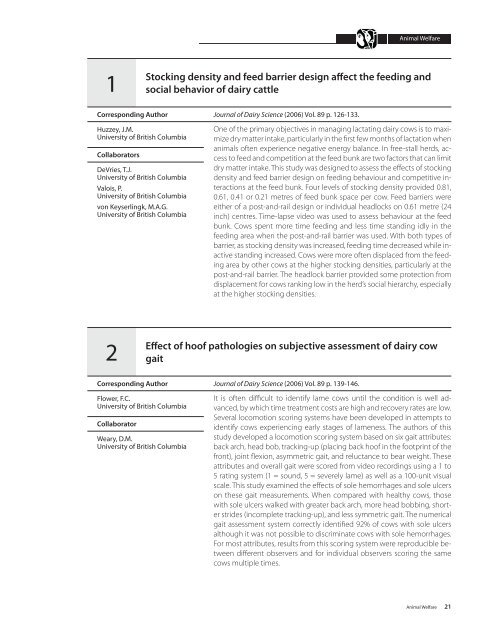A52-75-2007E.pdf - AgroMedia International Inc
A52-75-2007E.pdf - AgroMedia International Inc
A52-75-2007E.pdf - AgroMedia International Inc
Create successful ePaper yourself
Turn your PDF publications into a flip-book with our unique Google optimized e-Paper software.
Animal Welfare1Stocking density and feed barrier design affect the feeding andsocial behavior of dairy cattleCorresponding AuthorHuzzey, J.M.University of British ColumbiaCollaboratorsDeVries, T.J.University of British ColumbiaValois, P.University of British Columbiavon Keyserlingk, M.A.G.University of British ColumbiaJournal of Dairy Science (2006) Vol. 89 p. 126-133.One of the primary objectives in managing lactating dairy cows is to maximizedry matter intake, particularly in the first few months of lactation whenanimals often experience negative energy balance. In free-stall herds, accessto feed and competition at the feed bunk are two factors that can limitdry matter intake. This study was designed to assess the effects of stockingdensity and feed barrier design on feeding behaviour and competitive interactionsat the feed bunk. Four levels of stocking density provided 0.81,0.61, 0.41 or 0.21 metres of feed bunk space per cow. Feed barriers wereeither of a post-and-rail design or individual headlocks on 0.61 metre (24inch) centres. Time-lapse video was used to assess behaviour at the feedbunk. Cows spent more time feeding and less time standing idly in thefeeding area when the post-and-rail barrier was used. With both types ofbarrier, as stocking density was increased, feeding time decreased while inactivestanding increased. Cows were more often displaced from the feedingarea by other cows at the higher stocking densities, particularly at thepost-and-rail barrier. The headlock barrier provided some protection fromdisplacement for cows ranking low in the herd’s social hierarchy, especiallyat the higher stocking densities.2Effect of hoof pathologies on subjective assessment of dairy cowgaitCorresponding AuthorFlower, F.C.University of British ColumbiaCollaboratorWeary, D.M.University of British ColumbiaJournal of Dairy Science (2006) Vol. 89 p. 139-146.It is often difficult to identify lame cows until the condition is well advanced,by which time treatment costs are high and recovery rates are low.Several locomotion scoring systems have been developed in attempts toidentify cows experiencing early stages of lameness. The authors of thisstudy developed a locomotion scoring system based on six gait attributes:back arch, head bob, tracking-up (placing back hoof in the footprint of thefront), joint flexion, asymmetric gait, and reluctance to bear weight. Theseattributes and overall gait were scored from video recordings using a 1 to5 rating system (1 = sound, 5 = severely lame) as well as a 100-unit visualscale. This study examined the effects of sole hemorrhages and sole ulcerson these gait measurements. When compared with healthy cows, thosewith sole ulcers walked with greater back arch, more head bobbing, shorterstrides (incomplete tracking-up), and less symmetric gait. The numericalgait assessment system correctly identified 92% of cows with sole ulcersalthough it was not possible to discriminate cows with sole hemorrhages.For most attributes, results from this scoring system were reproducible betweendifferent observers and for individual observers scoring the samecows multiple times.Animal Welfare 21





